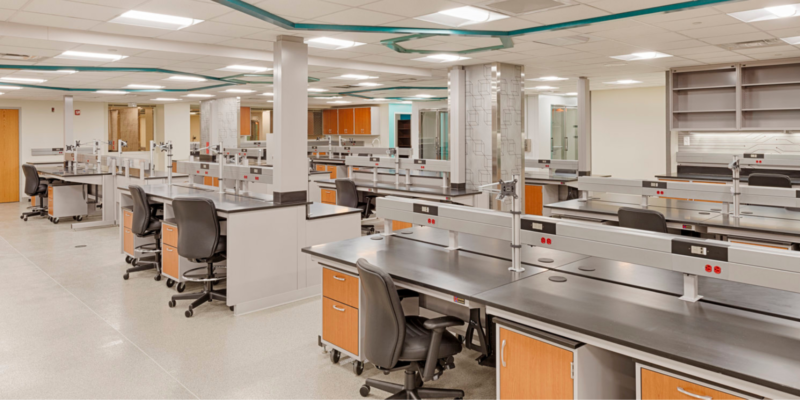Lab Design Starts Here: 770-932-1118
Key Tips to consider while buying Laboratory Chairs and Furniture

A close look at how to purchase proper laboratory seating and tables.
Working in awkward body postures can affect muscles, nerves, blood vessels, ligaments, and tendons. Therefore, what you sit on, is so important. Seating in laboratory environments is trending towards larger backs and seats, with a heightened focus on ergonomics. Selecting the right laboratory seating and learning to sit properly helps prevent musculoskeletal disorders and improves your overall health. It even improves productivity! When sitting aim to support your back, adjust your chair, and put your feet on the floor with even weight on both hips. Be sure your laboratory table is at a comfortable height, computer screen at eyelevel, and keyboard at a comfortable distance and angle. To assure that you are sitting with the best posture, follow these key tips when buying laboratory seating.
- Determine your budget
- Laboratory chairs, stools, and tables range in price to fit your budget as you decide how to set up your lab workspace.
- Selecting materials will make a big difference in the pricing. For example, seating made with cloth and vinyl are less expensive than leather.
- Shipping may be high depending on the type and quantity of the laboratory chairs, stools, and tables you order. Speak to LabDS about different shipping options and discounts.
- Study the best design suited for you
- Different laboratory tables and chairs are available to suit your lab space. When designing your lab layout, considerations like stools versus lab chairs will be part of your decision-making process.
- Look for the option to purchase your tables made-to-order to assure a unique work experience that maximizes your efficiency and productivity. For example, study your needs when it comes to length, width, height, and vertical adjustability to order accordingly.
- Choose a type of chair and determine your ergonomic considerations. For example, an adjustable lab chair or non-adjustable, high back or low back, swivel or stationery.
- Trends are toward larger backs and seats, with a heightened focus on ergonomics.
- Evaluate comfort and style
- The materials of a chair determine the level of comfort of the chair. Cloth or leather are often more comfortable than vinyl.
- Good seating gives good posture that result in fewer tension headaches, reduced backpain, increased energy levels, less tension in shoulders and neck, decreased risk of abnormal wearing of the joint surfaces, improved circulation, and digestion.
- Use and maintenance
- Specialty tables may be what your lab requires. For example, tables made from both phenolic resin and polypropylene are best for the harshest environments. Phenolic and polypropylene are both excellent at resisting moisture and acid, and either would be an ideal choice for a hospital central sterilization work area.
- For seating, if leather is chosen, it is resistant to odors and easy to clean, while cloth will stain easily and absorb odors from the lab.
- Research product warrantees and product reviews of the laboratory tables and chairs. For example, at Laboratory Design and Supply their products have a 13-year warranty.
Remember to have a neutral posture when sitting on a chair or stool. Your back should be mostly straight with only your natural curves in your lumbar area. Your shoulders should be back but relaxed and your ears should line up over your collarbones. With the right seating and tailored set up, you can do a lot to improve your health just by improving your posture. Investing in a few ergonomically designed products and learning to sit properly can go a long way to reducing wear and tear on your body and can really pay off as you avoid injuries, strains, and soreness in the future.
At LabDS we can help. As leaders in ergonomic studies for decades, LabDS understands how to deliver consistent, dependable performance in every lab stool, chair, and table. Call us at 777-932-1118 or contact us on our website to schedule a free consultation.

